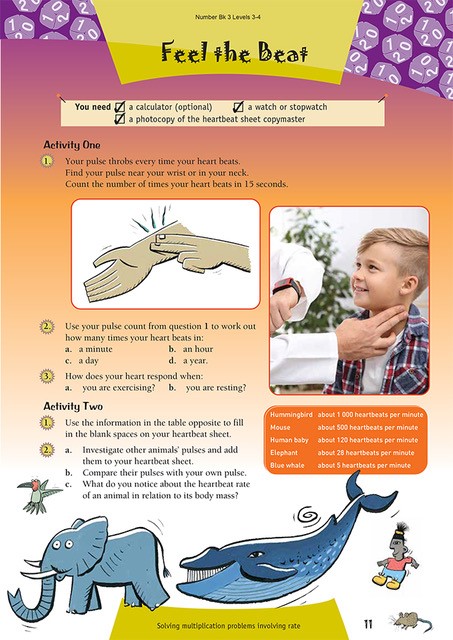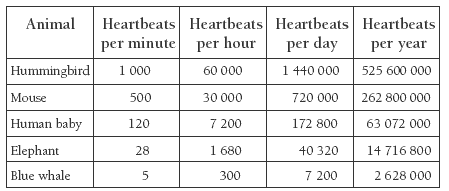This is a level 5 number activity from the Figure It Out series. It relates to Stage 8 of the Number Framework.
A PDF of the student activity is included.
Click on the image to enlarge it. Click again to close. Download PDF (346 KB)
calculate heartbeat rates
Heartbeat sheet (see Copymaster)
A watch or stopwatch
FIO, Level 3-4, Number, Book 3, Feel the Beat, page 11
Calculator (optional)
Activity One
Many students find the concept of heartbeats interesting, and it provides a good context for mathematical investigation. Suggested learning experiences for the Measurement strand of the curriculum include exploring the concept of change in relation to heartbeats and pulse rates. The activities involve calculating heartbeats per minute, hour, and so on and therefore introduce the idea of rate, which is comparing quantities of two different measures (for example, 100 heartbeats in 1 minute).
In question 1, the students are asked to take their pulse to work out the number of times their heart beats in 15 seconds. If the students have not already seen this page, you could introduce the activity by asking them to devise ways of finding and measuring their heartbeats so they get a measure of the number of beats per minute. It is likely that some students will know where they can take a pulse from and will be able to tell the class. The students may then decide to count the total number of beats in a minute before someone works out that it would be more efficient to count the number of beats in half a minute and double them or the number of beats in 15 seconds and multiply them by 4. A stopwatch is not essential for this task; a watch that shows seconds is adequate.
Question 2 involves multiplying the answer in question 1 by 4 (for a minute), then that answer by 60 (for an hour), then that answer by 24 (for a day), and finally, that answer by 365 (for a year). Rather than the students automatically using their calculators, have them explore number strategies for working out the answers. For example, the rate per hour can be found by multiplying by 10 and then by 6 and the rate per day by (rate per hour x 10 x 2) + (rate per hour x 4). The rate per year can be found in a similar way. Some students may suggest rounding and compensating as a strategy. For example, to find the rate per day: (rate per hour x 10 x 3) – (rate per hour x 6).
Activity Two
Most students will be fascinated by the investigations in this activity. Suggest that they add their own pulse counts from Activity One to the table and see how these compare with those of the various animals. They should be able to see that the larger the animal, the slower the heartbeat and, conversely, the smaller the animal, the faster the heartbeat.
The students may not know that a person’s heart rate decreases as they get older. Interested students could investigate why this happens.
Answers to Activities
Activity One
1.–2. Answers will vary. An average heartbeat rate for a 10-year-old is about 100 beats per min, and a maximum heartbeat rate for a 10-year-old is about 210 beats per min. The number of your heartbeats per minute, hour, day, and year will depend on your pulse count.
3. Answers will vary, but your heartbeat rate should be much higher after exercise.
Activity Two
1.
2. a. Answers will vary.
b. Answers will vary.
c. Heartbeat rates tend to be faster the smaller the animal is.

